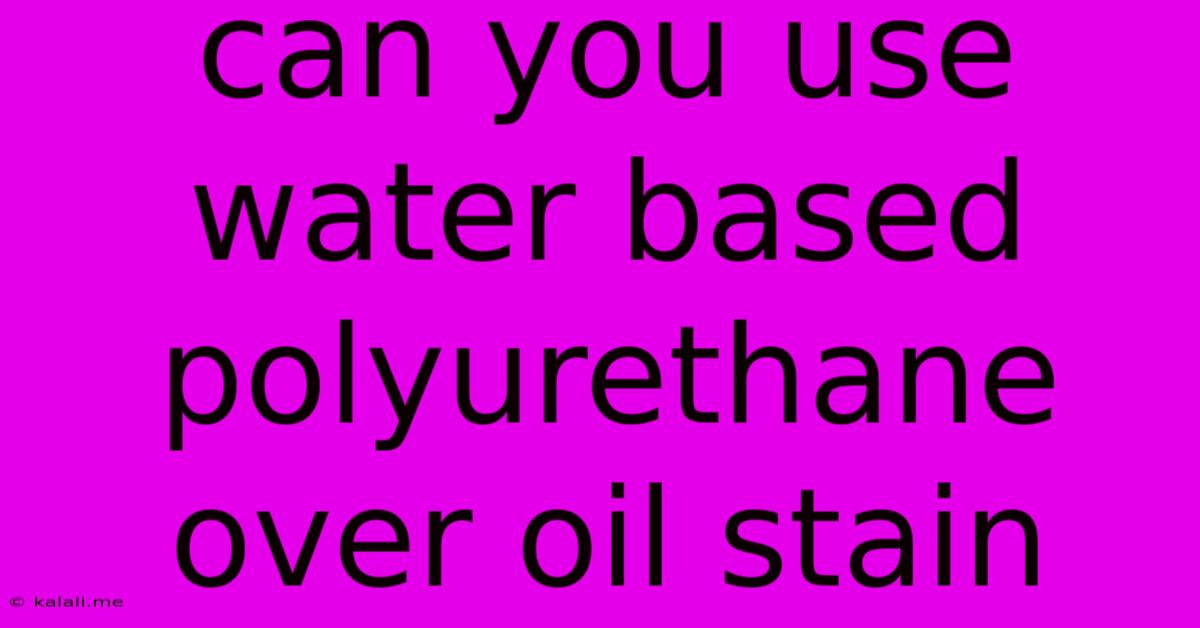Can You Use Water Based Polyurethane Over Oil Stain
Kalali
May 23, 2025 · 3 min read

Table of Contents
Can You Use Water-Based Polyurethane Over Oil Stain? The Definitive Guide
Meta Description: Wondering if you can apply water-based polyurethane over an oil-based stain? This comprehensive guide explores the compatibility, potential problems, and best practices for achieving a durable and beautiful finish. Learn the crucial steps and considerations for a successful project.
Applying a protective topcoat over your stained wood is crucial for longevity and beauty. But when it comes to mixing water-based polyurethane and oil-based stains, things can get a little tricky. The short answer is: generally, no, you shouldn't apply water-based polyurethane over an oil-based stain. However, understanding the why behind this is key to making the right choice for your woodworking project.
This guide will delve into the reasons for this incompatibility, explore potential problems you might encounter, and discuss alternatives to ensure a successful and long-lasting finish.
Why Water-Based Polyurethane and Oil-Based Stain Don't Mix
The fundamental issue lies in the differing chemical compositions of oil-based stains and water-based polyurethanes. Oil-based stains are, as the name suggests, oil-based. They penetrate deep into the wood grain, leaving behind a rich, deep color. Water-based polyurethane, on the other hand, is a water-based solution that sits on top of the wood, creating a protective layer.
The problem arises because the water in the polyurethane can react negatively with the oil in the stain. This can lead to several issues:
- Poor Adhesion: The polyurethane might not adhere properly to the oily surface, resulting in peeling, chipping, or bubbling. This is because the oil repels the water, preventing proper bonding.
- Blooming: The oil in the stain can bleed through the polyurethane, causing a cloudy or hazy appearance on the finished surface. This significantly detracts from the overall aesthetics.
- Delayed Drying: The oil-based stain can slow down the drying time of the polyurethane, potentially causing longer project completion times and an increased risk of imperfections.
What are the Alternatives?
If you've already applied an oil-based stain, your options are limited but not nonexistent:
-
Oil-Based Polyurethane: The most straightforward solution is to use an oil-based polyurethane topcoat. This ensures compatibility and a strong, durable finish. Oil-based polyurethanes are known for their superior durability and resistance to scratches and wear compared to water based alternatives. This is a critical consideration for high traffic areas.
-
Sanding and Re-staining: If you are unhappy with the stain itself, you can opt to carefully sand the stained surface and re-apply a stain that is compatible with the polyurethane of your choice. This is more labor intensive, but it gives you ultimate control over the final look of your project. Ensure you use the appropriate grit sandpaper.
-
Sheen Considerations: Remember to select a polyurethane (oil or water based) with a sheen that matches your desired aesthetic. Options range from flat (matte) to high gloss. Choosing the right sheen depends greatly on the intended use and overall design style.
Important Considerations Before Starting Your Project:
- Read Product Labels Carefully: Always check the manufacturer's instructions on both the stain and the polyurethane. This will highlight compatibility and provide essential application guidance.
- Test in an Inconspicuous Area: Before applying any finish to the entire piece, perform a small test application in a hidden area. This allows you to check for any potential issues like bleeding, adhesion problems, or undesirable reactions before committing to the entire surface.
- Proper Surface Preparation: Ensuring the wood is clean, dry, and properly prepared is vital for any finishing project, regardless of the materials used.
By carefully considering the compatibility of your chosen stain and polyurethane, you can avoid potential problems and achieve a beautiful, long-lasting finish for your woodworking projects. Remember, proper preparation and following manufacturer instructions are crucial for success.
Latest Posts
Latest Posts
-
No Crank No Start No Click
May 23, 2025
-
How To Convert Single Phase To 3 Phase
May 23, 2025
-
Bed Circular Tiny Round Black Bugs
May 23, 2025
-
How To Stop A Text Message
May 23, 2025
-
Why Did Voldemort Want To Kill Harry
May 23, 2025
Related Post
Thank you for visiting our website which covers about Can You Use Water Based Polyurethane Over Oil Stain . We hope the information provided has been useful to you. Feel free to contact us if you have any questions or need further assistance. See you next time and don't miss to bookmark.